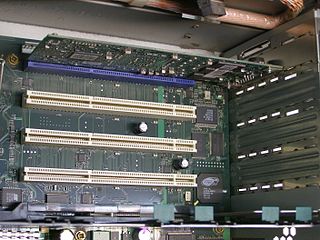In computing, a device control register is a hardware register that controls some computer hardware device, for example a peripheral or an expansion card.

Computing is any activity that uses computers. It includes developing hardware and software, and using computers to manage and process information, communicate and entertain. Computing is a critically important, integral component of modern industrial technology. Major computing disciplines include computer engineering, software engineering, computer science, information systems, and information technology.
A control register is a processor register which changes or controls the general behavior of a CPU or other digital device. Common tasks performed by control registers include interrupt control, switching the addressing mode, paging control, and coprocessor control.
In digital electronics, especially computing, hardware registers are circuits typically composed of flip flops, often with many characteristics similar to memory, such as:
Specific technologies use this terminology with a narrower meaning:
- The ISA PNP specification divides the registers of a device in two categories: control registers and configuration registers. One of the device control registers defined by ISA PNP is (for example) the Activate register, which turns the card on or off. [1]
- The Device Control Register is also the name of a specific register in the PCI Express architecture. It has fields that (among other things) control what is the maximum read request size (in bytes) that the device can make. [2]
- Device Control Register (DCR) is also the name of an IBM proprietary bus. Its stated design goal is to "transfer data between a DCR master, typically a CPU’s general purpose registers, and the DCR slave logic’s device control registers". [3] For example, the IBM MultiProcessor Interrupt Controller (MPIC) is connected up to four processors via a shared DCR bus, and in turn the MPIC handles up to 128 interrupt sources. [4]

PCI Express, officially abbreviated as PCIe or PCI-e, is a high-speed serial computer expansion bus standard, designed to replace the older PCI, PCI-X and AGP bus standards. It is the common motherboard interface for personal computers' graphics cards, hard drives, SSDs, Wi-Fi and Ethernet hardware connections. PCIe has numerous improvements over the older standards, including higher maximum system bus throughput, lower I/O pin count and smaller physical footprint, better performance scaling for bus devices, a more detailed error detection and reporting mechanism, and native hot-swap functionality. More recent revisions of the PCIe standard provide hardware support for I/O virtualization.
CoreConnect is a microprocessor bus-architecture from IBM for system-on-a-chip (SoC) designs. It was designed to ease the integration and reuse of processor, system, and peripheral cores within standard and custom SoC designs. As a standard SoC design point, it serves as the foundation of IBM or non-IBM devices. Elements of this architecture include the processor local bus (PLB), the on-chip peripheral bus (OPB), a bus bridge, and a device control register (DCR) bus. High-performance peripherals connect to the high-bandwidth, low-latency PLB. Slower peripheral cores connect to the OPB, which reduces traffic on the PLB. CoreConnect has bridging capabilities to the competing AMBA bus architecture, allowing reuse of existing SoC-components.

In computer architecture, a bus is a communication system that transfers data between components inside a computer, or between computers. This expression covers all related hardware components and software, including communication protocols.










